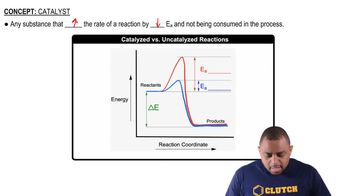The water supply for a midwestern city contains the following impurities: coarse sand, finely divided particulates, nitrate ions, trihalomethanes, dissolved phosphorus in the form of phosphates, potentially harmful bacterial strains, dissolved organic substances. Which of the following processes or agents, if any, is effective in removing each of these impurities: coarse sand filtration, activated carbon filtration, aeration, ozonization, precipitation with aluminum hydroxide?
Ch.18 - Chemistry of the Environment

Brown14th EditionChemistry: The Central ScienceISBN: 9780134414232Not the one you use?Change textbook
Chapter 18, Problem 82c
The concentration of H2O in the stratosphere is about 5 ppm. It undergoes photodissociation according to: H2O(g) → H(g) + OH(g)
(c) The hydroxyl radical, OH, can react with ozone, giving the following reactions:
OH(g) + O3(g) → HO2(g) + O2(g)
HO2(g) + O(g) → OH(g) + O2(g)
What overall reaction results from these two elementary reactions? What is the catalyst in the overall reaction? Explain.
 Verified step by step guidance
Verified step by step guidance1
Identify the two given elementary reactions: 1) OH(g) + O3(g) → HO2(g) + O2(g) and 2) HO2(g) + O(g) → OH(g) + O2(g).
To find the overall reaction, add the two elementary reactions together. This involves combining all reactants and products from both reactions.
Cancel out any species that appear on both sides of the combined equation. In this case, OH(g) appears as both a reactant and a product, so it can be canceled out.
After canceling, the remaining species will give you the overall reaction. Ensure that the equation is balanced in terms of both atoms and charge.
Identify the catalyst in the reaction. A catalyst is a substance that is present at the start and end of the reaction without being consumed. In this case, OH(g) is regenerated and thus acts as a catalyst.

Verified video answer for a similar problem:
This video solution was recommended by our tutors as helpful for the problem above.
Video duration:
4mWas this helpful?
Key Concepts
Here are the essential concepts you must grasp in order to answer the question correctly.
Photodissociation
Photodissociation is a process where a chemical compound breaks down into its components due to the absorption of light energy. In the context of the question, water vapor (H2O) in the stratosphere absorbs ultraviolet light, leading to the formation of hydrogen (H) and hydroxyl radicals (OH). This reaction is significant in atmospheric chemistry as it initiates various reactions involving reactive species.
Elementary Reactions
Elementary reactions are the simplest types of chemical reactions that occur in a single step, involving a direct interaction between reactants to form products. The question presents two elementary reactions involving hydroxyl radicals and ozone, which together contribute to the overall reaction. Understanding these reactions is crucial for analyzing how they combine to yield a net reaction.
Recommended video:
Guided course

Reaction Mechanism Overview
Catalysis
A catalyst is a substance that increases the rate of a chemical reaction without being consumed in the process. In the overall reaction derived from the two elementary reactions, the hydroxyl radical (OH) acts as a catalyst, as it is produced in one of the reactions and consumed in another, facilitating the transformation of ozone (O3) into other products while remaining unchanged.
Recommended video:
Guided course

Catalyzed vs. Uncatalyzed Reactions
Related Practice
Textbook Question
22
views
Textbook Question
An impurity in water has an extinction coefficient of 3.45⨉103 M-1 cm-1 at 280 nm, its absorption maximum (A Closer Look, p. 576). Below 50 ppb, the impurity is not a problem for human health. Given that most spectrometers cannot detect absorbances less than 0.0001 with good reliability, is measuring the absorbance of a water sample at 280 nm a good way to detect concentrations of the impurity above the 50-ppb threshold?
Textbook Question
The concentration of H2O in the stratosphere is about 5 ppm. It undergoes photodissociation according to: H2O(g) → H(g) + OH(g) (b) Using Table 8.3, calculate the wavelength required to cause this dissociation.
1
views
